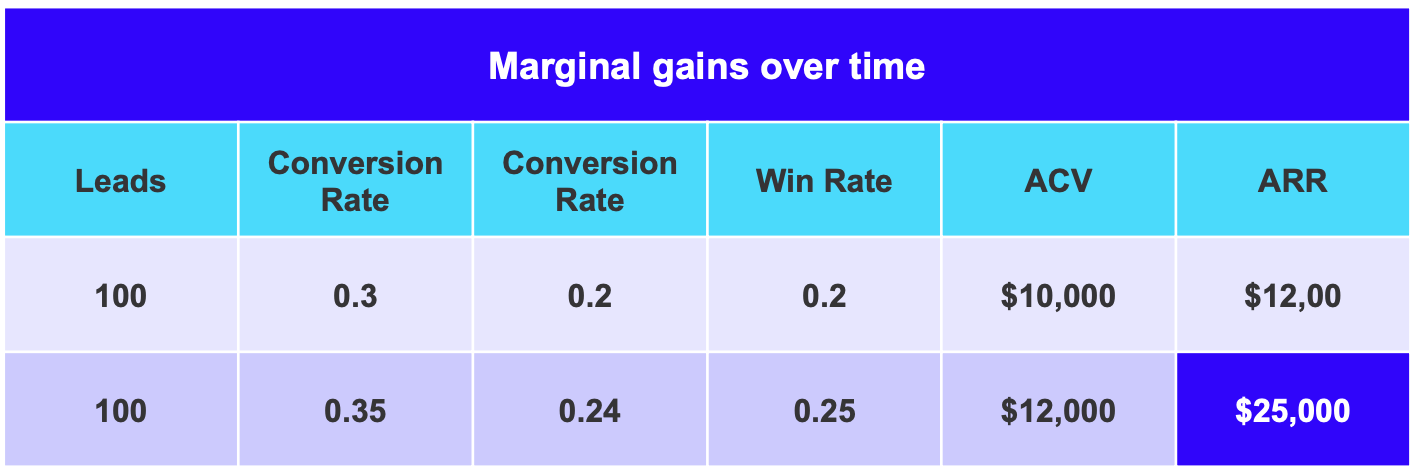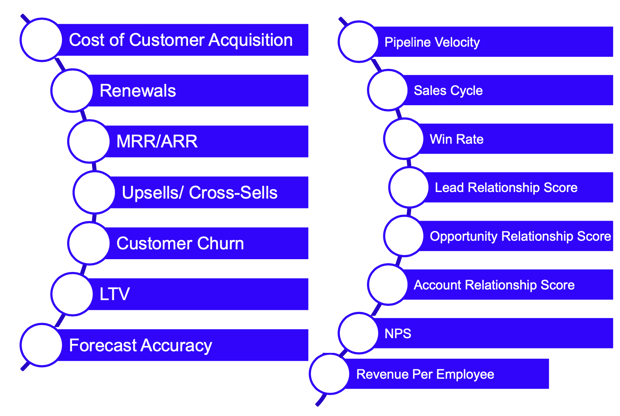Subscribe to ur Blog

What Are RevOps?
Revenue operations (or RevOps) better align Marketing, Sales, and Customer Success functions to encourage better revenue growth across an organization.
It’s a framework to connect your technology, processes and strategy and create a frictionless revenue-generating machine while delighting your customer at every
stage.
Due to the nature of trying to build a successful company in ‘real- time’, businesses have been a collection of interconnected but disparate departments. Yes, they all have the same goal (the company’s ultimate success), but they also have their own individual needs and constraints. Likewise, the larger they get, each department also has its own ‘Head of’, Vice President, or Director with a unique approach.
In most organizations, sales operations report to the Head of Sales, marketing operations report to the Head of Marketing, and Customer Success to, well, you get the idea.
Each team has its own set of goals, tools and priorities. And, for the most part, it works. However, the challenge with this way of working is that disparate systems mean friction points where sales conversions are potentially lost for a variety of reasons.
Through better collaboration and visibility, RevOps looks to close the numerous and various gaps across people, data, processes, technology, and team accountability through improved operational efficiency. This will drive a more cohesive business by unifying teams through shared goals and by sharing information.
Picture an orchestra: a collection of individuals who all need to work in unison to achieve a result, a pleasant melody. Can you imagine every chair playing their own tune, in their own time at their own volume? That’s most organizations. But RevOps (much like an orchestral conductor) unites disparate business functions, to get them working in unison to achieve a collective result more powerful than their collective parts.
So, how do we get to this utopian state of optimal growth?
Short answer, It’s not easy and requires an in-depth examination of your entire business, focusing on the good, the bad and the downright ugly. But the improved financial results are well worth the effort.
Since 2019, there’s been a 300% increase in RevOps-related roles on LinkedIn and a 57% increase in companies implementing RevOps strategies or building RevOps teams.
According to a recent HubSpot blog, companies that implement RevOps have seen the following impact:
- 10-20% increase in sales productivity
- 15% increase in profitability
- 19% increase in speed of growth
- 71% improvement in stock performance
- 100-200% increase in digital marketing ROI
Impressive, right? But what if the system is working well and delivering the results we hear you say? Well, if it ain't broke, don’t fix it. Right?
Not quite. According to HubSpot, 60% of current operations professionals end up repeating or double handling business tasks due to a lack of team alignment. This means targets get missed, goals aren’t reached and stakeholders across the board get frustrated. It’s a lose/lose for everybody.
But once you get the orchestra all playing the same song, your business will thrive.
In most business deals, the greatest revenue is often achieved after the point of sale. I.e., delighting customers through a range of appropriate cross-selling, up-selling and re-selling opportunities after the initial conversion.
To provide this type of customer-first experience, you’ll need to spend some cash upfront. But, the money you’ll likely spend to secure a customer (or the cost of acquisition) is only a small fraction of what you can expect to earn from them over the course of their customer lifecycle.
To provide this type of customer-first experience, you’ll need to spend some cash upfront. But, the money you’ll likely spend to secure a customer (or the cost of acquisition) is only a small fraction of what you can expect to earn from them over the course of their customer lifecycle.
Once you recognise and accept this shift in customer focus, you’ll be able to shift your energy towards fostering customer loyalty and driving more revenue.
These are the 6 main ways SaaS has altered relationships between customers and the businesses they buy from:
- Most revenue is achieved after the point-of-sale.
- Traditional funnels are dead, and now customer journeys are non-linear.
- Customers now have thousands of options at their fingertips.
- Customers now consistently demand a more personal, frictionless
experience. - There are typically more stakeholders involved in a purchase decision.
- The rate of change is ever increasing.
How to Break Down Silos For Go-To-Market Teams

Historically, most organizations separate their Marketing, Sales and Customer Success departments as per the diagram above. But as you can see, this often leads to siloed data sets, tech stacks and processes.
And the issue isn’t just the siloing of data. It also creates at least three clear friction points for the customer as they pass from one function to the other as they move through the sales process.
Now let’s explore the same journey from a RevOps position:

As you can see, once RevOps is at play in the go-to-market arm of a business, it’s easier to recognise sales, marketing, and customer success as a single function with a clear alignment between data, technology, and processes.

Now let’s see how Marketing, Sales & Customer Service can be better connected through RevOps.

It’s important to note RevOps doesn’t sit above or below the existing VPs of Sales, Marketing or Customer Success. The role acts as a unifying entity to ensure the tools and processes of each are best aligned for maximum results.
By having an overview of all depts, RevOps can spot and fix the numerous friction and drop-off points that siloed growth functions often have.
The 5 main benefits of RevOps:

In short, think of these benefits as:
- Making better decisions faster
- Getting the right data in hand to make those decisions
- Building trust and predictable pipeline
With this in mind, there are two key points you should try and remember to communicate when approaching your go-to-market teams with the idea of RevOps:
-
- How having a codified, replicable process will help deals close faster
- How RevOps will help the organization build a consistent approach to scaling
6 pillars of RevOps
If you take anything from this blog, let it be the following pillars:

Key performance indicators (KPIs) for RevOps
There are several key performance indicators (KPIs) to pay attention to when it comes to RevOps. When you’re building out your RevOps function, the three main things to evaluate are:
-
Customer churn
-
Revenue per employee
-
Account relationship score
Useful Areas for RevOps to Measure:

As should hopefully be clear, RevOps is about maximizing the efficiency of your Marketing Sales and Customer Service functions by better aligning tools and processes to reduce conversion friction and delight the customer at every stage.
Without getting into too much detail, each of the indicators above tells a story about your customer journey. They’re all data points with which a savvy RevOps practitioner can better understand how to improve the customer journey and reduce friction.
-
Pipeline velocity too slow? You might need to reduce friction in your quote send and sign off process.
-
Poor renewal rate? Customer Success may need to share upsell data with Sales earlier in the process.
-
NPS score low? Maybe customers need delighting earlier in the sales process.
Of course, these are only three example suggestions but they highlight how data points are more than numerical information; they’re insights into where the customer journey can be improved by better aligning how a business interacts with a customer.
How to Build a Revenue Machine with HubSpot
1. Align teams & map the customer journey
Before a lead even enters your CRM, it’s important to condition all three departments (Marketing / Sales / Customer Service) so they fully understand how and why a RevOps approach works.
By knowing exactly where, when and how customer handovers will occur and intersect as the prospect moves through your sales cycle, you can reduce friction, speed up onboarding and ensure the customer’s, not the organisation’s needs, are the number one priority at all times.
2. Map the Customer Journey and Ideal Customer Profile (ICP).
With a clear understanding of expectations, it’s now time to step into the customer’s shoes.
Create a process diagram and map every stage your customer goes through as they move through your sales process - from the first time they encounter your brand messaging to the moment they sign their one year renewal.
It may seem excessive, but it’s a powerful insight into where and when marketing, sales and customer service can often compete for the customer’s attention to satisfy their own departmental needs.
For example, why make a customer repeat information when it can be collected and shared at a single point? What used to be the responsibility of the Customer Service team can now be captured during the fact-finding call by the sales team. The information Sales historically needed can instead be captured by Marketing to allow for a smoother handover from MQL to SQL.
Get into detail and start working on this before the first meeting happens. Make sure everyone is on the same page with who your go-to-market teams should be targeting, what their common pain points are, what their typical business goals are, and how your product or service offering is going to solve their problems.
If there’s a clear picture of the results your organisation can provide to customers, it’s a lot easier for go-to-market teams to centre these conversations around current and future customers, and tell a compelling story that gets them in the door, and keeps them loyal to your organisation. If you’re able to show the value effectively, it’ll be hard for them to picture life without your product or service.
3. Process and Data for Key Stages
Ensure your team members are given access to data at the right time to reduce and standardise the sales cycle. One way to think about the key stages is to follow HubSpot’s lead; awareness, consideration, decision. Going about your RevOps process in these stages is a great way to put your team in the same mindset as your potential customer. As consumers themselves, it probably won’t be a hard concept to get across.
Think of the “awareness” stage as the first impression your organisation makes on the customer. They could be coming across your website for the first time, and digging around before as they make their shortlist of vendors to consider. What does your first impression look like right now? Is it a good one? Make sure that it is.
The “consideration” stage is when the customer is weighing all of their options. They’re thinking about things like pricing, onboarding, ease of use, and even your company’s values. Like your first impression, there is also a secondary impression stage, and sometimes the decision can be emotional. With this in mind, arm your go-to-market team members with the tools and resources they need to be successful in continuing the conversation. Don’t set them up for failure.
Lastly, the “decision” stage is when the customer in question decides which product or service is the best fit. By the time they get here, they should have all of the information they need to make the right decision for them. Ensure that you have everything in place for this to happen before they reach the decision portion of their buyer’s journey.
4. Measure and Identify Where to Improve When it Comes to Speed and Conversion
Keep in mind that incremental improvements can have exponential results. As we like to say, slow progress is still progress. As you go down the road of RevOps, don’t be shy about iterating on your current process and getting rid of the fluff that isn’t actually helping your team or your business.
If you can cut your tech stack, do it. If you need new documentation or templates for your sales team, get them created. No matter the changes you make, as long as they promote efficiency and unity in your team, you’ve likely made the right decision.
5. Bring Tools That Deliver Insights Faster or Serve as Force Multipliers
Make sure that whoever’s leading the charge with RevOps also puts a focus on getting the right tools from the right vendors (like HubSpot). Sure, the process of evaluating and implementing new technology is daunting, and it’s certainly not appealing when you have to consider the scepticism of some people on your team. However, if you have someone that’s dedicated to choosing tools that will actually create efficiencies (and probably result in more money made), it’ll be easier to push the agenda for technology adoption along.
Keep in mind that incremental improvements can have exponential results. As we like to say, slow progress is still progress. As you go down the road of RevOps, don’t be shy about iterating on your current process and getting rid of the fluff that isn’t actually helping your team or your business.
If you can cut your tech stack, do it. If you need new documentation or templates for your sales team, get them created. No matter the changes you make, as long as they promote efficiency and unity in your team, you’ve likely made the right decision.
6. Build Feedback Loops for Rapid Knowledge Sharing and Optimization
Make sure everyone in your go-to-market “orchestra” is on the same page of the “song.” Don’t let the fear of shifting gears or making changes stand in your way, either. As you go about implementing your RevOps strategy within your organisation, be sure to encourage openness and transparency within your team. What does transparency look like?
In this case, prompt people to give feedback on how the process is going in real-time. Of course, you may not be able to act on every change suggested, but the sooner these things come to light, the sooner they can be acted on and optimized for success in the short and long term.
Incremental Gains in RevOps
Long story short, you don’t want to underestimate the value of a well-oiled revenue engine. Here’s why:

Once your RevOps strategy and practical applications are up and running, you’ll start to see the fruits of your labor. But, don’t be surprised or discouraged if you don’t see results right away. It’s going to take time for people on your team to adjust to this new way of operating.
Onboarding and implementing are both short term pains that will result in long term gains. Think about the bigger picture, and be willing to put in the work overtime. The real key to success with RevOps? Easy - it’s just getting started.
The sooner you start, the sooner you can improve your processes, and then sooner you can see results.
7 Common RevOps Challenges
RevOps is a powerful way to drive more revenue through your business, But as a relatively new operational concept, there are a few potential difficulties you need to keep in mind:

RevOps FAQs
What does a RevOps team look like and how does it scale with company size? What skills are needed? And how do you get started building a RevOps team?
A: Different teams are going to need different resources. Start with a leader; get someone in who has experience in this area. Be brave, as no one has all the answers as to what they’re hoping to achieve with RevOps. RevOps is not an admin function, but strategic.
Is the VP of RevOps the same as a CRO?
A: No, CRO should instead be working alongside the VP of Revenue Operations. People in RevOps don’t need to be good at running a sales process themselves. CRO needs to understand the commercial side and drive the business forward. RevOps needs to understand data, processes, and technology that will support GTM teams.
What size of company do you expect to have a separate RevOps team?
A: Depends on the operation and what you’re trying to achieve. Smaller, more agile companies, for example, may not have the resources to hire multiple roles in a RevOps team framework; however, they can take steps towards overall team alignment by establishing an internal RevOps committee formed by leaders within the different GTM departments.
This way, conversations and decisions can be focused around overall company goals, and initiatives can be planned and executed based on shared understanding between teams.
Medium to large-sized organisations with more resources available towards growth will want to take steps toward building a dedicated RevOps team, and consider widening the mandate to include ownership of business insights, tools and processes, or training and enablement alongside general operational ownership.
Typically medium-sized businesses will begin by hiring for roles attached to specific teams (Sales Operations, Marketing Operations, etc.) However, it’s important to ensure that these roles are moving in lockstep with your internal RevOps committee to prevent the silos from forming within the business.
Larger organisations, and organisations with more complex needs or hierarchies, will absolutely want to hire a Revenue Operations leader or executive to sit alongside the executives of other teams to foster alignment, drive strategic conversations, and to own and champion any RevOps-related initiatives across the business.
This may require some internal restructuring, but it is important to bring staff, process, and knowledge together under one operational umbrella that is fully aligned with the wider company goals.
Most GTM teams have siloed tech stacks. How do you best manage the transition given the level of disruption when it comes to ripping and replacing tech?
A: It doesn’t have to be a rip and replace situation. Start by having one function responsible for all of it. Let the operation be responsible for what they’re good at. So many efficiencies can be brought by first getting everyone on the same page. Tiny changes at each stage of the process have exponential growth. We suggest checking out HubSpot's CRM Platform, which can help you consolidate your tech stack and unify your data to a single source of truth.
How is this different to a modern marketing team with a cross-functional growth team targeting improvements at each stage of the customer lifecycle?
A: Focused RevOps function leads to a consistent message all across the organization.
Which parts of the existing organisation show the most resistance to this approach?
A: Sales is usually the first to push back. With strong management, this can be avoided. The whole point is to generate more efficiency for scale, and more revenue for the organisation. Ultimately, sales wants to earn more money. Even if they grumble, stick with being consistent. Imagine the opportunity. Don’t see the shortsighted nature of sales be a deterrent; you want them focused on the next deal.
Integrations have the power to enhance all aspects of your business. No matter the software you use to run your company, you can find integrations that can help simplify your processes, optimize your efforts, and empower your fellow employees. So, find the right integration marketplace for your software and begin connecting to the applications suited for your business needs.
Interested in learning more about how our services can help your business create a better customer experience with integrations? Let's talk.
Related Reads
Master HubSpot tools & unleash a world of endless possibilities!
Unlock Your HubSpot Powerhouse: Contact Us to Transform Your Digital Journey!

Ranya Barakat
Ranya is a serial entrepreneur with over 8 years of experience working on the HubSpot CRM. She loves pushing her sleeves up , and getting s*** done. When she is not running her HubSpot partner agency, you can find her upside down on her yoga mat.
Subscribe to our blog
The best information about inbound marketing, sales, guides and migrations.


